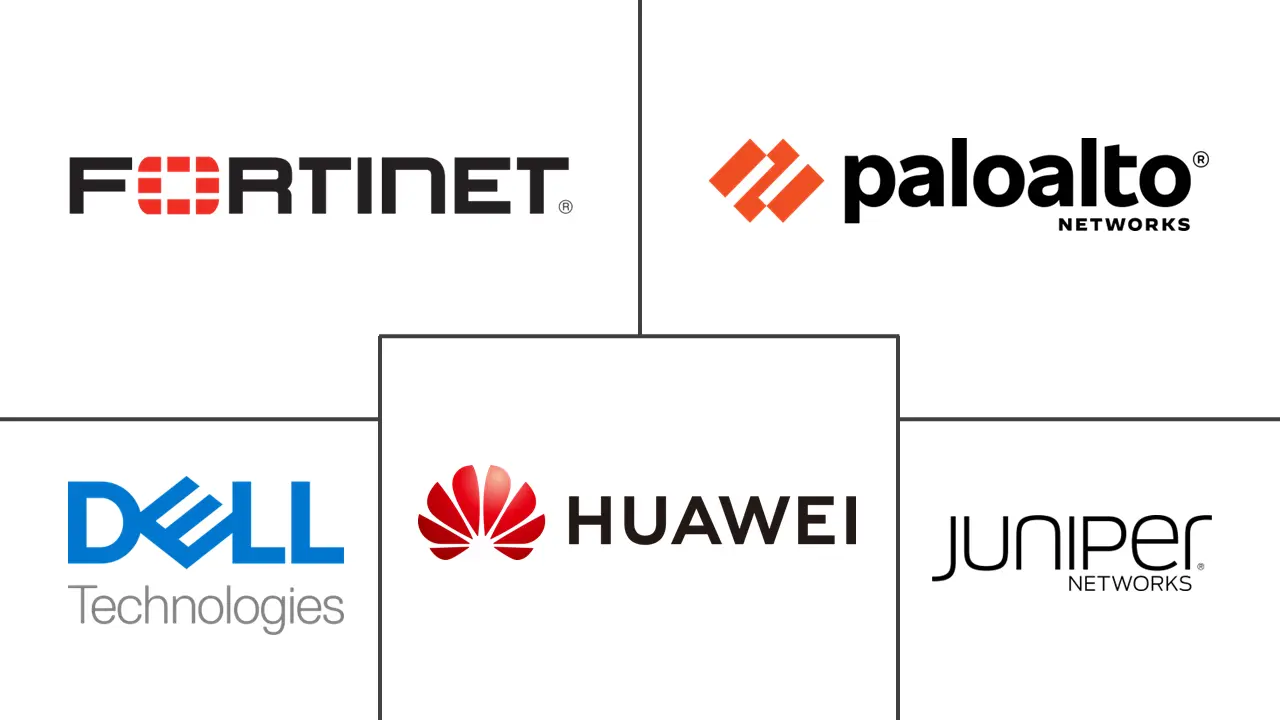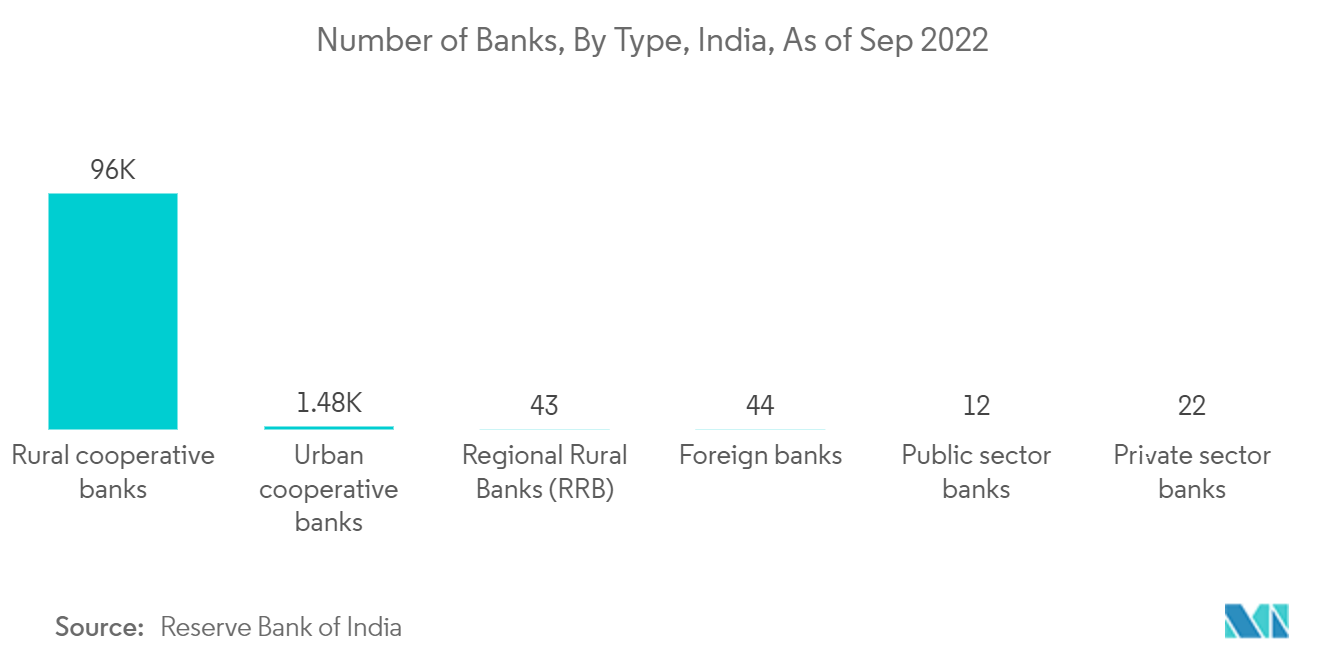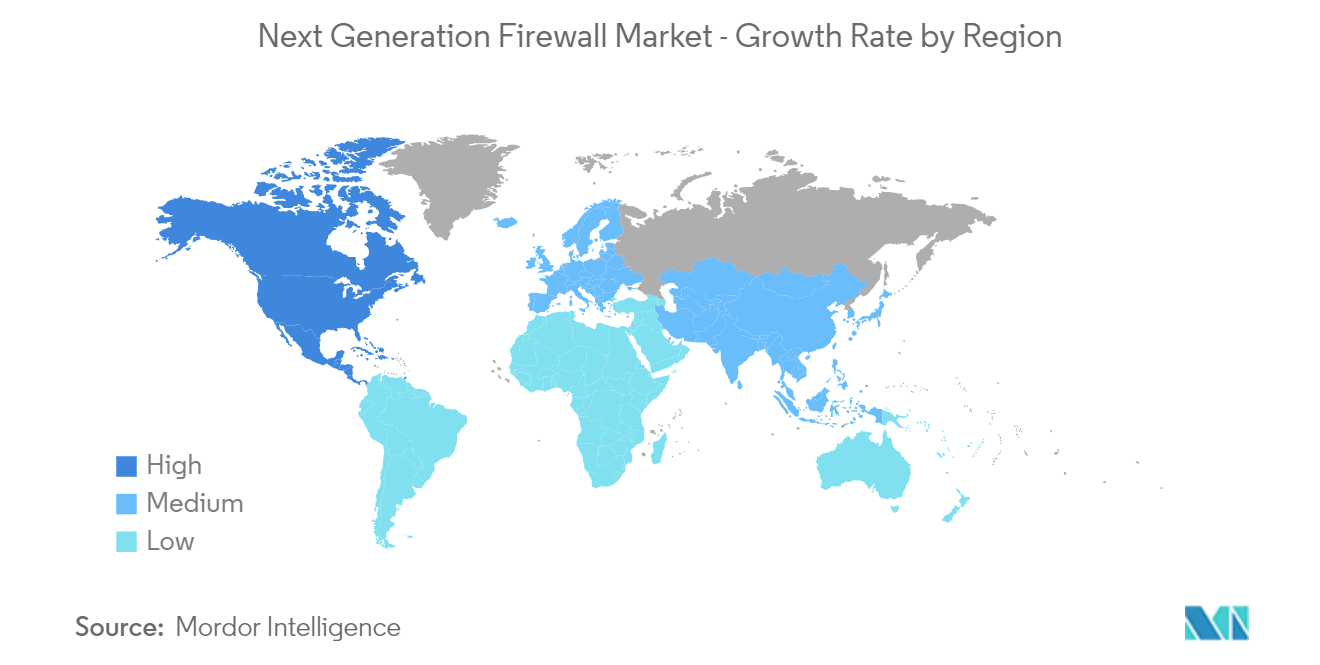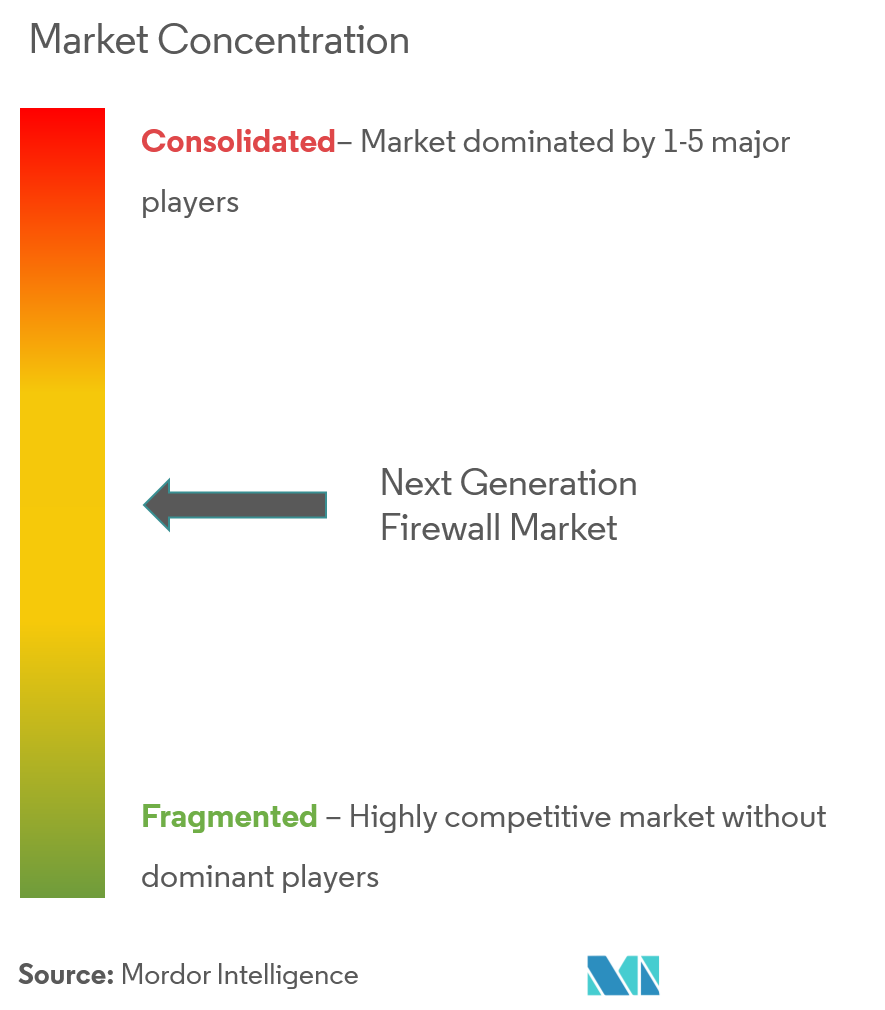
| Study Period | 2021 - 2030 |
| Base Year For Estimation | 2024 |
| Forecast Data Period | 2025 - 2030 |
| CAGR | 12.00 % |
| Fastest Growing Market | Asia Pacific |
| Largest Market | North America |
| Market Concentration | Medium |
Major Players
*Disclaimer: Major Players sorted in no particular order |
Next Generation Firewall Market Analysis
The Next Generation Firewall Market is expected to register a CAGR of 12% during the forecast period.
- One of the primary factors driving the growth of the next-generation firewall market is the rising global adoption of the Internet of Things. The increased adoption of next-generation firewalls for effectively managing logs while preserving the integrity and better business continuity and the increasing demand for dealing with massive amounts of computer-generated log data drive market expansion.
- Adopting next-generation security solutions helps increase the company's product and operational efficiencies. Machine learning, artificial intelligence (AI), and tighter network connectivity are used in next-generation endpoint security to provide more comprehensive and adaptable protection. Next-generation security systems use real-time user and system behavior analysis to examine executables. Existing security technologies advancing toward context-aware computing technology enable businesses to recognize sophisticated threats. Payment problems caused by system failures in IT infrastructure can disrupt global commerce, while network connection loss affects government functions such as law enforcement. Over the projected period, this aspect is expected to generate possibilities for next-generation firewall vendors.
- Internet-based cybersecurity tools are available and commonly utilized to defend cloud-based applications. More internet usage increases the likelihood of data breaches and simple data manipulation, which is impossible in an internal security system. As a result, organizations need to start using internet-based security solutions or revealing internet firewall management tools. Providers provide clear and multifactor safety solutions for an acceptable level of protection. Businesses must also plan for potential DoS (Denial-of-Service) attacks. However, it is relatively difficult to identify these attacks by security analytics solutions without proper protective measures and solutions. As a result, demand for next-generation firewall systems is likely to rise to maintain robust and efficient security systems.
- The companies are incorporating new applications/Solutions in their products to meet customers' demands. For instance, in July 2021, The FortiGate 3500F next-generation firewall (NGFW) was announced by Fortinet, a prominent player of comprehensive, integrated, and automated cybersecurity solutions, to defend enterprises with hybrid data centers from the ever-growing threat landscape and ransomware attacks. The FortiGate 3500F has some of the highest performance metrics in the business, incorporating TLS1.3 and automated threat protection after encryption. With its security-driven networking strategy, the FortiGate 3500F also includes zero-trust network access (ZTNA) capabilities, ensuring consistent security and a seamless user experience for any user at any location.
- Several constraints in the next-generation firewall market are preventing it from growing. A next-generation firewall is highly effective but expensive, making it difficult for medium-sized businesses to buy it. One of the primary constraints in the next-generation firewall is the high cost of systems. Because of the high cost of the systems, only large corporations can afford to use them. Another market limitation is that small and medium firms use traditional methods and antiquated technology and want to keep their technology the same, which constitutes a market restraint.
- Government agencies are allotting strategic funds to strengthen their digital interface in the post-pandemic era. For instance, In 2021, following recent hospital breaches, French President Emmanuel Macron announced a plan to invest EUR 1 billion (USD 1.2 billion) to strengthen cybersecurity in France, with EUR 350 million (approx. USD 400 million USD) set aside for hospitals.
Next Generation Firewall Market Trends
BFSI Sector is Expected to Capture Prominent Market Share
- The banking, financial services, and insurance (BFSI) industry are one of the critical infrastructure segments that face multiple data breaches and cyber-attacks, owing to the massive customer base that the sector serves and the financial information at stake. Being a highly lucrative operation model that has phenomenal returns along with the added upside of relatively low risk and detectability, cybercriminals are optimizing a plethora of diabolical cyberattacks to immobilize the financial sector. These attacks' threat landscape ranges from Trojans, ATMs, ransomware, mobile banking malware, data breaches, institutional invasion, data thefts, fiscal breaches, etc.
- With a strategy to secure their IT processes and systems, secure customer critical data, and comply with government regulations, public and private banking institutes are implementing the latest technology to prevent cyber attacks. Besides, with greater customer expectations, rising technological capabilities, and regulatory requirements, banking institutions are pushed to adopt a proactive security approach. With the growing technological penetration and digital channels, such as internet banking, mobile banking, etc., online banking has become customers' preferred choice for banking services. There is a significant need for banks to leverage advanced authentication and access control processes.
- In February this year, the Department of Justice (DoJ) and industry group Bankers Association of the Philippines (BAP) signed a memorandum of understanding (MoU) to raise cybersecurity awareness and combat cybercrime in the Philippines. The BAP aims to strengthen the banking industry's cyber-resilience and develop a collaborative partnership with the Justice Department to achieve a coordinated, collective, and strategic cyber response through information sharing and collaboration in the wake of rising cybercrime incidents in the country.
- Many banks are expected to drive the demand for the next-generation firewall market. For instance, According to, in India, there were 34 licensed private and public banks as of September this year. Data breaches lead to an exponential cost increase and loss of valuable customer information. Data breaches result in an exponential increase in expenditures as well as the loss of critical client information. According to the Identity Theft Resource Center, the number of data compromise victims in the banking and financial sector of the United States climbed to 160 million in Q3 last year, up from Q1 and Q2 combined. Cyber attackers are looking for the simplest way to build a financial gain assault against many financial services businesses.
- In January this year, the federal banking regulators of the United States issued a cybersecurity rule requiring prompt notification of a breach. The proposed rule is poised to provide the agencies with an early warning of numerous computer security incidents. It would need notification as soon as possible and by 36 hours after a banking enterprise determines that an incident has occurred. Such regulations could control cyber attacks in the banking sector of the United States.

North America Accounts for a Major Share of the Market
- The North American region currently dominates the global market, owing to the high preference of businesses for the security of the high volume of sensitive and important data used by them and the continuous adoption of high-performing network security solutions by organizations.
- In recent times, the major firms in the United States suffered from the fatal WannaCry ransomware attack when data was encrypted, and ransom was asked in cryptocurrency. The attack happened because the data of millions of customers was unsecured. Hence, stringent government regulations regarding consumer privacy were imposed. This factor is expected to drive the market's growth in this region.
- The Health Insurance Portability and Accountability Act, a federal statute of the United States, reported the increase of breaches by 25% year-over-year in 2020 in the Healthcare Data Breach Report published in January last year, with 29,298,012 healthcare records breached.
- Other sectors are also equally witnessing growth in the major cyber security issues in the country. For instance, according to the Data Protection Report 2021 from Shred It, the rate of companies (Large and SMBs) experiencing a data breach increased incredibly last year compared to 2020. The rate increased to 74% for large businesses the previous year compared to 43% in 2020, whereas the rate increased to 61% for SMBs from a low rate of just 12% on a year-on-year basis.
- Moreover, in light of the Russia - Ukraine conflict and a virtually endless cycle of threat campaigns and vulnerability disclosures towards the country, the US State Department, in April this year, launched a new agency, the Bureau of Cyberspace and Digital Policy (CDP), responsible for developing online defense and privacy-protection policies and direction as the Biden administration seeks to integrate cybersecurity into America's foreign relations.

Next Generation Firewall Industry Overview
The next-generation firewall market is moderately consolidated, with the presence of many small and big players in the domestic as well as the international market. The market is moderately concentrated with the key strategies adopted by the major players in product innovation and mergers and acquisitions to stay ahead of the competition. Some major players in the market are Juniper Networks Inc., Dell Technologies, and Huawei Technologies Co. Ltd, among others.
In August 2022, Hillstone Networks, a provider of innovative and accessible cybersecurity solutions, introduced two new models in its A-Series next-generation firewalls (NGFWs), the A7600 and A6800, to assist enterprises in securing their expanding network edge, delivering powerful network security capabilities and driving sustainability with solutions in a compact 1RU form factor.
In October 2022, Clavister, a European cybersecurity company for mission-critical applications, announced a renewed agreement with Nokia to continue their long-standing collaboration and satisfy the growing demand for 5G security. Nokia will integrate NetShield among the solutions offered in Nokia Managed Firewall Services (MFS) and Nokia Managed Security Services (MSS) as part of the new collaboration arrangement. Nokia MFS blends Clavister's superior telco-grade capabilities (which handle the technology) with the key services model centered on the firewall to provide a comprehensive solution for Nokia's customers as a service.
Next Generation Firewall Market Leaders
-
Juniper Networks Inc.
-
Palo Alto Networks Inc.
-
Dell Technologies
-
Huawei Technologies Co. Ltd
-
Fortinet Inc.
- *Disclaimer: Major Players sorted in no particular order

Next Generation Firewall Market News
- November 2022: Fortinet unveiled its FortiGate Cloud-Native Firewall (CNF) on Amazon Web Services. The new cybersecurity solution, accessible as a software-as-a-service (SaaS), is intended for AWS-using companies seeking enterprise-grade next-generation firewall (NGFW) features with cloud-native compatibility. FortiGate CNF includes FortiGuard AI-driven security services for real-time detection and protection against malicious external and internal threats and is powered by FortiOS for a consistent network security experience across Amazon Web Services (AWS) and on-premises settings.
- August 2022: Palo Alto Networks recently announced a collaboration with Amazon Web Services (AWS) to launch the new Palo Alto Networks Cloud NGFW for AWS, a managed next-generation firewall (NGFW) service designed to simplify securing AWS deployments, allowing organizations to accelerate their pace of innovation while remaining highly secure. Cloud NGFW for AWS, which is only available on AWS, offers Palo Alto Networks' renowned security to organizations' cloud installations in seconds-recognizing that customers prefer to devote their time and resources to developing applications and running their businesses rather than managing cloud network security infrastructure. Cloud NGFW for AWS transfers operational responsibility to Palo Alto Networks, which includes deployment, maintenance, availability, and scale.
Next Generation Firewall Industry Segmentation
A next generation firewall is a network security device that provides capabilities beyond a traditional firewall. While a traditional firewall typically provides stateful inspection of incoming and outgoing network traffic, a next-generation firewall includes additional features, like application awareness and control, integrated intrusion prevention, and cloud-delivered threat intelligence.
The next generation firewall market is segmented by enterprise size (small and medium enterprises and large enterprises), solution (cloud-based and hardware), end-user industry (government, healthcare, and BFSI), and geography(North America, Europe, Asia-Pacific, Latin America, Middle East and Africa).
The market sizes and forecasts are provided in terms of value (USD million) for all the above segments.
| By Size of Enterprise | Small and Medium Enterprises (SMEs) | ||
| Large Enterprises | |||
| By Solution | Cloud-Based | ||
| Hardware | |||
| By End-User Industry | BFSI | ||
| IT and Telecom | |||
| Government | |||
| Healthcare | |||
| Manufacturing | |||
| Retail | |||
| Other End-User Industries | |||
| Geography | North America | United States | |
| Canada | |||
| Europe | United Kingdom | ||
| Germany | |||
| France | |||
| Rest of Europe | |||
| Asia-Pacific | China | ||
| Japan | |||
| India | |||
| Rest of Asia-Pacific | |||
| Latin America | Mexico | ||
| Brazil | |||
| Rest of Latin America | |||
| Middle East & Africa | United Arab Emirates | ||
| Saudi Arabia | |||
| South Africa | |||
| Rest of Middle East & Africa | |||
Next Generation Firewall Market Research FAQs
What is the current Next Generation Firewall Market size?
The Next Generation Firewall Market is projected to register a CAGR of 12% during the forecast period (2025-2030)
Who are the key players in Next Generation Firewall Market?
Juniper Networks Inc., Palo Alto Networks Inc., Dell Technologies, Huawei Technologies Co. Ltd and Fortinet Inc. are the major companies operating in the Next Generation Firewall Market.
Which is the fastest growing region in Next Generation Firewall Market?
Asia Pacific is estimated to grow at the highest CAGR over the forecast period (2025-2030).
Which region has the biggest share in Next Generation Firewall Market?
In 2025, the North America accounts for the largest market share in Next Generation Firewall Market.
What years does this Next Generation Firewall Market cover?
The report covers the Next Generation Firewall Market historical market size for years: 2021, 2022, 2023 and 2024. The report also forecasts the Next Generation Firewall Market size for years: 2025, 2026, 2027, 2028, 2029 and 2030.
Our Best Selling Reports
Next Generation Firewall Industry Report
Statistics for the 2025 Next Generation Firewall market share, size and revenue growth rate, created by Mordor Intelligence™ Industry Reports. Next Generation Firewall analysis includes a market forecast outlook for 2025 to 2030 and historical overview. Get a sample of this industry analysis as a free report PDF download.




